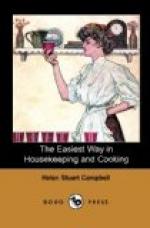To every pound of meat and bone allow one quart of cold water, one even teaspoon of salt, and half a saltspoon of pepper. Let the meat stand till the water is slightly colored with its juice; then put upon the fire, and let it come slowly to a boil, skimming off every particle of scum as it rises. The least neglect of this point will give a broth in which bits of dark slime float about, unpleasant to sight and taste. A cup of cold water, thrown in as the kettle boils, will make the scum rise more freely. Let it boil steadily, but very slowly, allowing an hour to each pound of meat. The water will boil away, leaving, at the end of the time specified, not more than half or one-third the original amount. In winter this will become a firm jelly, which can be used by simply melting it, thus obtaining a strong, clear broth; or can be diluted with an equal quantity of water, and vegetables added for a vegetable soup.
The meat used in stock, if boiled the full length of time given, has parted with all its juices, and is therefore useless as food. If wanted for hashes or croquettes, the portion needed should be taken out as soon as tender, and a pint of the stock with it, to use as gravy. Strain, when done, into a stone pot or crock kept for the purpose, and, when cold, remove the cake of fat which will rise to the top. This fat, melted and strained, serves for many purposes better than lard. If the stock is to be kept several days, leave the fat on till ready to use it.
Fresh and cooked meat may be used together, and all remains of poultry or game, and trimmings of chops and steaks, may be added, mutton being the only meat which can not as well be used in combination; though even this, by trimming off all the fat, may also be added. If it is intended to keep the stock for some days, no vegetables should be added, as vegetable juices ferment very easily. For clear soups they must be cooked with the meat; and directions will be given under that head for amounts and seasonings.
The secret of a savory soup lies in many flavors, none of which are allowed to predominate; and, minutely as rules for such flavoring may be given, only careful and frequent tasting will insure success. Every vegetable, spice, and sweet herb, curry-powders, catchups, sauces, dried or fresh lemon-peel, can be used; and the simple stock, by the addition of these various ingredients, becomes the myriad number of soups to be found in the pages of great cooking manuals like Gouffee’s or Francatelli’s.
Brown soups are made by frying the meat or game used in them till thoroughly brown on all sides, and using dark spices or sauces in their seasoning.
White soups are made with light meats, and often with the addition of milk or cream.
Purees are merely thick soups strained carefully before serving, and made usually of some vegetable which thickens in boiling, as beans, pease, &c, though there are several forms of fish purees in which the foundation is thickened milk, to which the fish is added, and the whole then rubbed through a common sieve, if a regular puree-sieve is not to be had.




